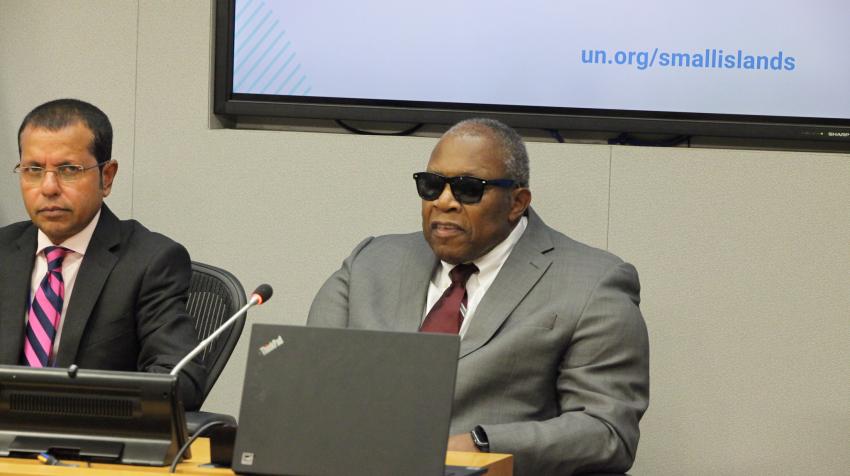14 March 2024 - What is the Multidimensional Vulnerability Index (MVI), what does it measure and why is it important for countries in special situations? Ahead of the Fourth International Conference on Small Island Developing States (SIDS4) this coming May, Ambassador Walton Webson, Permanent Representative of Antigua and Barbuda to the United Nations, explains.
What is the Multidimensional Vulnerability Index (MVI), what does it measure and why is it important for countries in special situations? Ahead of the Fourth International Conference on Small Island Developing States (SIDS4) this coming May, Ambassador Walton Webson, Permanent Representative of Antigua and Barbuda to the United Nations, explains.
What is the Multidimensional Vulnerability Index (MVI) and what does it measure?
“The MVI is a new international quantitative benchmark to measure structural vulnerability and the lack of structural resilience across multiple dimensions of sustainable development at the national level. It can be used to complement Gross National Income per capita (GNI pc).
It consists of two levels:
1. A universal level quantitative assessment of structural vulnerability and (lack of) structural resilience using a common methodology for all developing countries, which is presented via a summary index number to rank countries and;
2. Vulnerability and Resilience Country Profiles (VRCPs) which are a more detailed, tailored, and individualized characterization of a country’s vulnerability and resilience factors, including non-structural resilience. These national profiles, prepared by individual countries, can be used, among other things, to direct support and cooperation toward addressing specific vulnerabilities that are being identified and to enhance resilience.
Results are expressed in scores. While a lower MVI score indicates that a country is relatively less vulnerable to the effects of external shocks, it should not be interpreted to mean that the country is completely immune to external shocks.
Given the evolving nature of global challenges, including disasters, conflicts, and health pandemics like COVID-19, there is a pressing need for a nuanced understanding of vulnerability and resilience that transcends traditional economic indicators like the Gross Domestic Product (GDP) and GNI pc.“
Why is this measurement important for developing countries and countries in special situations?
“Access or eligibility to development finance for many developing countries is often linked to or determined by a country’s GNI per capita. The system has been further complicated by the many special windows or ad hoc exceptions that have been developed or created and which are often only triggered by a major external shock. These exceptions often focus on post-shock response, relief, and recovery, rather than building long-term resilience.
These approaches are useful and are a recognition of the challenges currently experienced by many developing countries in accessing sufficient development resources to meet their sustainable development needs. But they do not adequately consider the intricate nature of the interactions between structural, inherent disadvantages, especially the multifaceted dimensions of vulnerability, and the pursuit of sustainable development.
While GNI pc is useful for examining a country’s income and its development trajectory to date, it has limitations, including its inability to account for inflation, income disparity, poverty, wealth, or savings. GNI pc measures a country’s average income flow at a specific time. It does not reflect potential income fluctuations, including those stemming from external shocks and stressors.
As such, the MVI could address the limitations of using GNI pc alone by providing a comprehensive measure of vulnerability that includes factors beyond income. This would allow for a more nuanced understanding of a country’s development needs and eligibility for concessional assistance.
The MVI will be useful in making a credible case that a country’s structural vulnerability justifies stronger international support. It can help capture those specific vulnerabilities and by extension allow countries to advocate for tailored solutions and international attention. The index can be a basis for countries to qualify for specialized assistance programs designed to address their unique challenges. It underscores the need for international cooperation and solidarity in supporting the most vulnerable nations towards achieving sustainable development, as the highest needs are directly proportional with the level of vulnerability.”
How does this measurement relate to GNI and GDP for example?
“The MVI can be used as a complementary measurement to GNI and GDP to assess developing countries’ vulnerability, based on a defined selection of variables that reflect countries inherent features such as size, distance to market and exposure to the impacts of climate change, just to name a few.
While GNI and GDP provide economic assessments based on income and production respectively, the MVI adds a critical dimension by considering a range of additional factors that make part of the country’s GNI and production volatile and susceptible to losses. Should a country plan future development based on its entire GNI pc or should it acknowledge that a part of it, as measured by the MVI is volatile and uncertain for planning purposes? Should GNI pc be considered alone when a country’s access to development finance is decided, or the MVI-adjusted GNI pc should be taken into consideration as a more reliable measurement of the country’s situation?
When answering these questions, it is important to note that vulnerability does not necessarily mean poverty. A wealthy country may also be vulnerable although they have the resources to overcome their vulnerability. One effect of the MVI is to separate the concepts of vulnerability and poverty. By providing a comprehensive measure of vulnerability that includes factors beyond income, it allows for a more nuanced understanding of a country’s development needs and hence better allocation of development resources.”
For more information:
Fourth International Conference on Small Island Developing States (SIDS4)
Multidimensional Vulnerability Index (MVI) for Small Island Developing States (SIDS)

